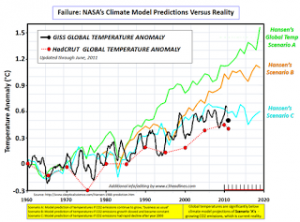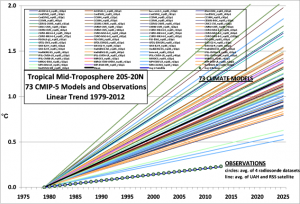Experts from around the world confirm the arrival of a new ice age: forecasts by chills even on the prestigious Forbes magazine
Friday, June 7, 2013, 24:33 to FF
 The global temperature rise of the late 19th century repeats the pattern of the Mini Ice Age, writes Peter Ferrara to Forbes: "the trend of global temperature goes, not the rising levels of CO2, but the temperature cycles of oceanic ' Pacific Decadal Oscillation (Pacific Decadal Oscillation, PDO) and the Atlantic multidecadal oscillation (Atlantic Multidecadal Oscillation, AMO). "
The global temperature rise of the late 19th century repeats the pattern of the Mini Ice Age, writes Peter Ferrara to Forbes: "the trend of global temperature goes, not the rising levels of CO2, but the temperature cycles of oceanic ' Pacific Decadal Oscillation (Pacific Decadal Oscillation, PDO) and the Atlantic multidecadal oscillation (Atlantic Multidecadal Oscillation, AMO). "
Every 20-30 years, the very cold water on the ocean floor, rises to the
surface, where it causes a slight cooling effect on global temperatures
until the sun does not heat that water. That water then warmed contributes to temperatures slightly warmer, until the next cycle.
 Those cycles of ocean temperature are the reasons why the temperatures
were raised between 1915 and 1945, when CO2 emissions were much lower
than in recent years.
The change in a cycle of cold ocean temperature, mainly the PDO, is the
main reason why global temperatures fell from 1945 until the late '70s,
despite the increase of CO2 emissions during the period of
post-industrialization war that affected the entire globe.
Those cycles of ocean temperature are the reasons why the temperatures
were raised between 1915 and 1945, when CO2 emissions were much lower
than in recent years.
The change in a cycle of cold ocean temperature, mainly the PDO, is the
main reason why global temperatures fell from 1945 until the late '70s,
despite the increase of CO2 emissions during the period of
post-industrialization war that affected the entire globe.
The 20-30-year cycles of ocean temperature are back warm from the late
70s to the late 90s, major reason why the temperatures were raised at
that time.
But the heating is finished 15 years ago, and global temperatures have
stopped rising since then, although the global CO2 emissions have risen. As reported by the 'Economist, "The
world has added approximately 100 billion tons of carbon into the
atmosphere between 2000 and 2010. Almost a quarter of all CO2 emitted by
humanity since 1750."
Yet, no heating during that period. Why? The greenhouse effect of CO2 is weak and marginal compared to the natural causes of climate change.

At first, the current stalemate of global warming was attributed to ocean cycles returning in the cold phase. But something far more nefarious developed during this period: sunspots follow the rhythms of the short term of about 11 years, and rates of long-term ranging from 90 to 200 years.
The number of sunspots has declined substantially in the last cycle of
11 years, while, in the present, solar activity has collapsed. NASA has issued a report in January of this year, which states that "the sun could be the beginning of an event type Maunder. The current solar cycle is the weakest in 50 years. "
The radio program The Voice of Russia said in April that "global
warming, which has been the subject of much discussion in recent years,
should instead give priority to climatic cooling. According
to scientists Pulkovo Observatory in St. Petersburg, solar activity is
decreasing, so that even the average annual temperatures will begin to
decline. British and American scientists are now agreed that the predictions of climatic cooling are now far from groundless. "
The statement quoted Yuri Nagovitsyn of 'Pulkovo Observatory, who argues that "solar activity is declining. The solar cycle of 11 years does not make a significant climate change - only 1-2%. The impact of the 200-year cycle is much larger - more than 50%. In this respect, we may have a cooling period lasts 200-250 years. "In other words, a return to a Mini Ice Age.

The 'German Herald reported in March that the German meteorologists have found that "the beginning of 2013 is the coldest of the last 208 years" and cite the Russian scientist Habibullo Abdussamatov Pulkovo Observatory, which declares that "this
is test an input into a mini Ice Age. After studying sunspots and their
relationship to climate change on Earth, I would say that we are now in
an inevitable advance toward a deep drop in temperatures. "
Confidence in Global Warming is collapsing even in the much devout
Europe, which is experiencing increasingly rigid winters that have begun
to invade even the spring. Christopher Booker, in an article in the Sunday Telegraph writes that "in
this century, the average winter temperatures are fell by 1.45 ° C,
more than double the increase that has characterized the period from
1850 to 1999, and double the increase in temperatures recorded in the
twentieth century. "
Even Britain Met Office,
almost be considered the headquarters of the global warming advocates,
admitted last December that there would be no more increases in
temperature at least until 2017.
 "Global warming will never become the problem that many try to exaggerate. Human emissions of CO2 make up only 4-5% of total global emissions, including natural causes. Atmospheric concentrations of CO2 in the distant geological ages were much, much higher than today, yet life went on. Perhaps because the impact of temperature on the increase in the concentration of CO2 declines logarithmically. This means there is a natural limit on how much CO2 can actually heat the planet "- says Peter Ferrara to Forbes -" There
is a fundamental problem with the temperatures recorded in this period
in which we are living, when the climate science is met and confused
with science politicized. Recordings
made from the ground, under the control of the Met Office, NASA and
NOAA, show more warming than they reveal instead satellites. But the satellite measurements have been in turn endorsed by weather balloons. And 'when it comes to the ground that the information is distorted.
"What now you can not help but notice is the great difference between
the temperatures of the real world and the projections of climate models
of the Intergovernmental Panel for Climate Change Nations United (Intergovernmental Panel on Climate Change, IPCC). That's why "from 1999 to 2011, forecasting temperatures of 11 years on 12 of the Met Office were too high," he wrote in January the corresponding climate BBC Paul Hudson.
"Global warming will never become the problem that many try to exaggerate. Human emissions of CO2 make up only 4-5% of total global emissions, including natural causes. Atmospheric concentrations of CO2 in the distant geological ages were much, much higher than today, yet life went on. Perhaps because the impact of temperature on the increase in the concentration of CO2 declines logarithmically. This means there is a natural limit on how much CO2 can actually heat the planet "- says Peter Ferrara to Forbes -" There
is a fundamental problem with the temperatures recorded in this period
in which we are living, when the climate science is met and confused
with science politicized. Recordings
made from the ground, under the control of the Met Office, NASA and
NOAA, show more warming than they reveal instead satellites. But the satellite measurements have been in turn endorsed by weather balloons. And 'when it comes to the ground that the information is distorted.
"What now you can not help but notice is the great difference between
the temperatures of the real world and the projections of climate models
of the Intergovernmental Panel for Climate Change Nations United (Intergovernmental Panel on Climate Change, IPCC). That's why "from 1999 to 2011, forecasting temperatures of 11 years on 12 of the Met Office were too high," he wrote in January the corresponding climate BBC Paul Hudson. 
No comments:
Post a Comment